2013 FORD SUPER DUTY warning
[x] Cancel search: warningPage 3 of 95

POWER STROKE DIESEL ENGINE
Note:Your vehicle’s powertrain control systems can detect and store
information about vehicle modifications that increase horsepower and
torque output such as whether or not performance-enhancing powertrain
components commonly referred to as “performance chips” have been
used. This information cannot be erased and will stay in the system’s
memory even if the modification is removed. The information can be
retrieved by Ford Motor Company, Ford of Canada, and service and
repair facilities when servicing your vehicle. This information may be
used to determine if repairs will be covered by warranty.
Note:Some aftermarket products may cause severe engine/transmission
and/or exhaust system damage; refer to your warranty information for
more information.
Your new diesel engine will feel, drive and function somewhat differently
than a gasoline engine. Therefore it is very important that you read and
thoroughly familiarize yourself and others operating the vehicle with this
guide. A special procedure for turning off the diesel engine is in the
Starting and Stopping the Enginechapter.It is important to read
and understand this material in order to maintain the best
service life for your engine.
This supplement will acquaint you with the Power Stroke diesel engine.
It provides recommendations on engine care and operating procedures.
For complete vehicle information, also refer to yourOwner’s Manual
included with the vehicle. It also describes equipment and gives
specifications for equipment that was in effect when this guide was
approved for printing, and should be considered a permanent part of the
vehicle.
Ford may discontinue models or change specifications without any notice
and without incurring obligations.
WARNINGS
Throughout this guide, you will find warnings identified by the warning
symbol. Warnings remind you to be especially careful to reduce the risk
of personal injury.
Introduction
2
2013 Diesel(67l)
Supplement, 1st Printing
USA(fus)
Page 7 of 95
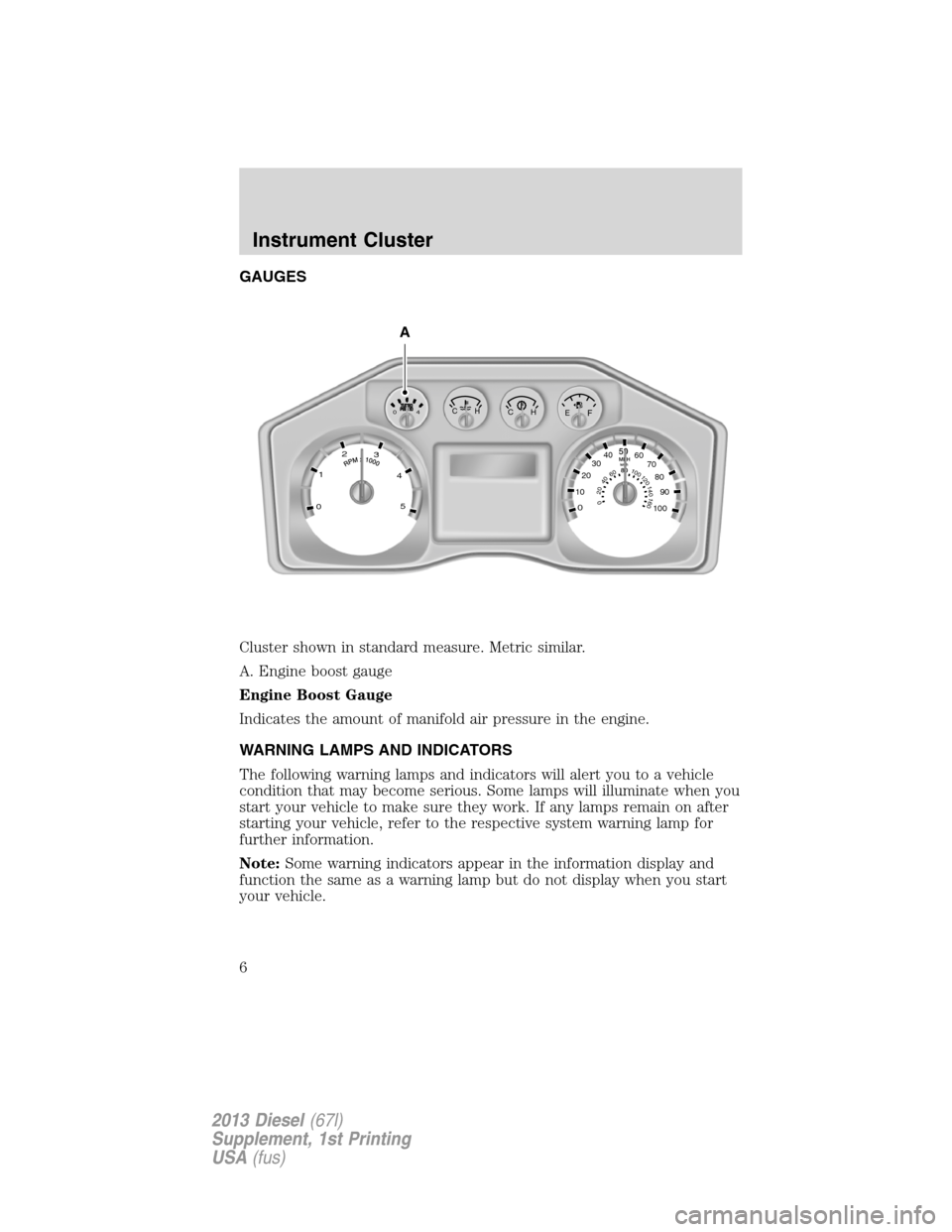
GAUGES
Cluster shown in standard measure. Metric similar.
A. Engine boost gauge
Engine Boost Gauge
Indicates the amount of manifold air pressure in the engine.
WARNING LAMPS AND INDICATORS
The following warning lamps and indicators will alert you to a vehicle
condition that may become serious. Some lamps will illuminate when you
start your vehicle to make sure they work. If any lamps remain on after
starting your vehicle, refer to the respective system warning lamp for
further information.
Note:Some warning indicators appear in the information display and
function the same as a warning lamp but do not display when you start
your vehicle.
A
60
70
80
90
100
02
0406
01001201401600
10203040012
3
4
5
CH04CHEF
Instrument Cluster
6
2013 Diesel(67l)
Supplement, 1st Printing
USA(fus)
Page 8 of 95
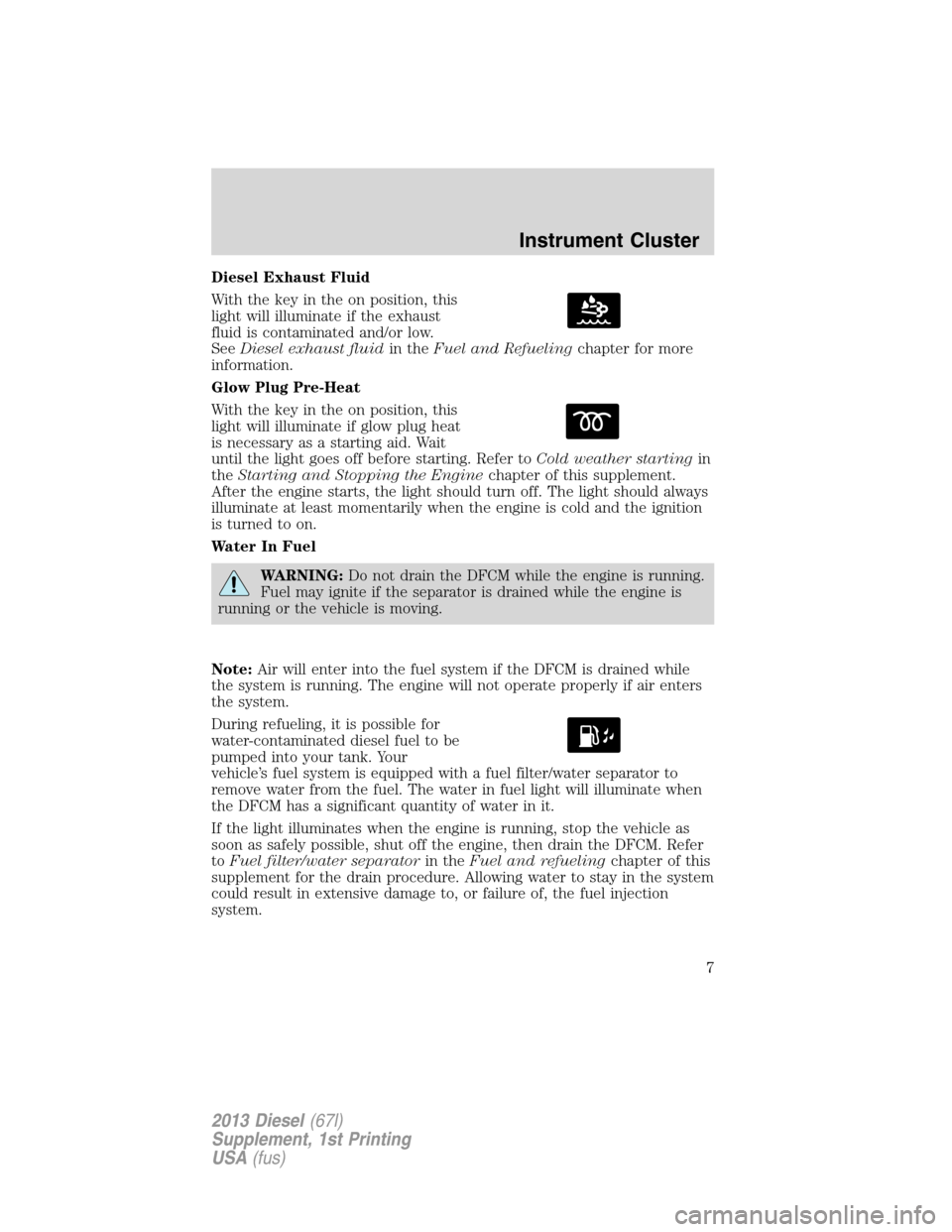
Diesel Exhaust Fluid
With the key in the on position, this
light will illuminate if the exhaust
fluid is contaminated and/or low.
SeeDiesel exhaust fluidin theFuel and Refuelingchapter for more
information.
Glow Plug Pre-Heat
With the key in the on position, this
light will illuminate if glow plug heat
is necessary as a starting aid. Wait
until the light goes off before starting. Refer toCold weather startingin
theStarting and Stopping the Enginechapter of this supplement.
After the engine starts, the light should turn off. The light should always
illuminate at least momentarily when the engine is cold and the ignition
is turned to on.
Water In Fuel
WARNING:Do not drain the DFCM while the engine is running.
Fuel may ignite if the separator is drained while the engine is
running or the vehicle is moving.
Note:Air will enter into the fuel system if the DFCM is drained while
the system is running. The engine will not operate properly if air enters
the system.
During refueling, it is possible for
water-contaminated diesel fuel to be
pumped into your tank. Your
vehicle’s fuel system is equipped with a fuel filter/water separator to
remove water from the fuel. The water in fuel light will illuminate when
the DFCM has a significant quantity of water in it.
If the light illuminates when the engine is running, stop the vehicle as
soon as safely possible, shut off the engine, then drain the DFCM. Refer
toFuel filter/water separatorin theFuel and refuelingchapter of this
supplement for the drain procedure. Allowing water to stay in the system
could result in extensive damage to, or failure of, the fuel injection
system.
Instrument Cluster
7
2013 Diesel(67l)
Supplement, 1st Printing
USA(fus)
Page 9 of 95
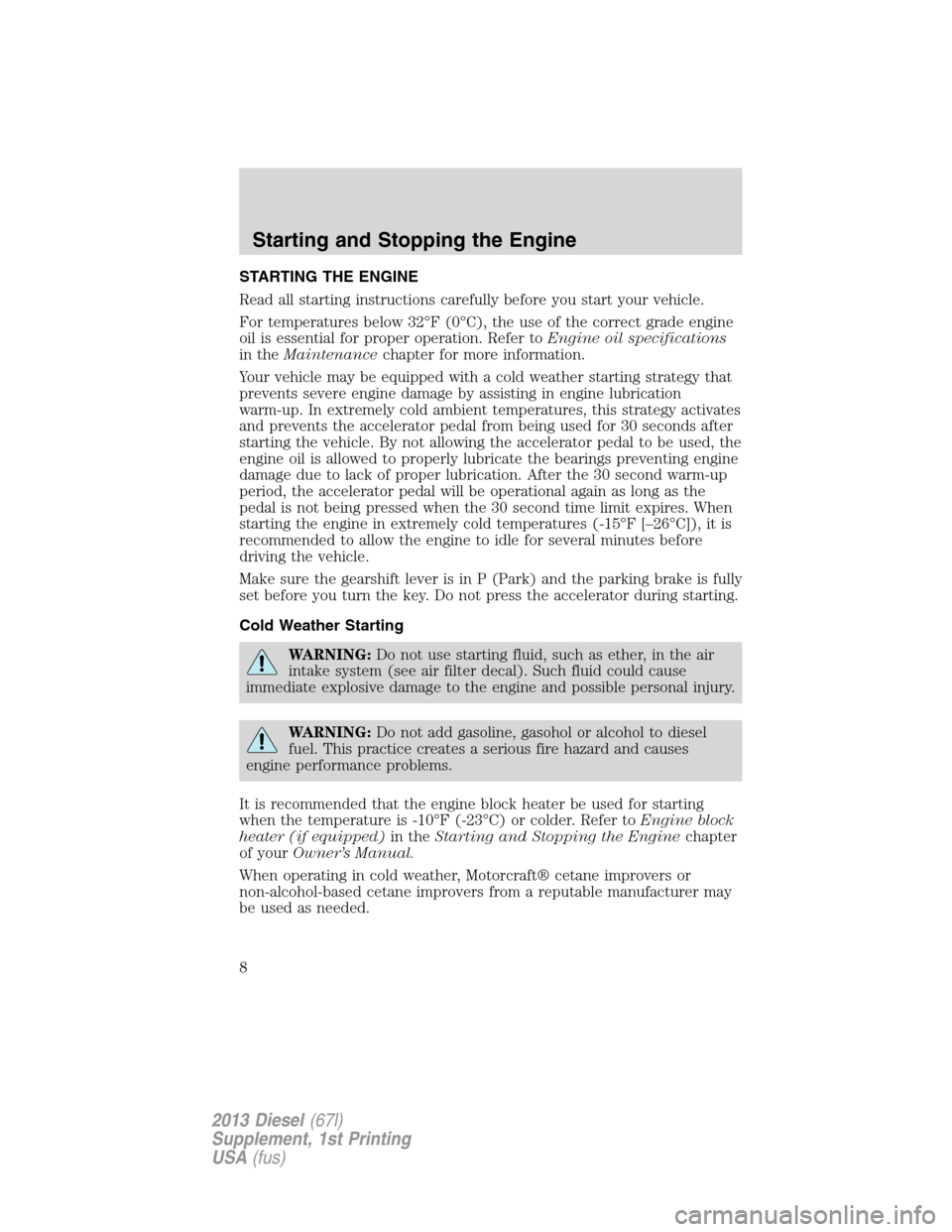
STARTING THE ENGINE
Read all starting instructions carefully before you start your vehicle.
For temperatures below 32°F (0°C), the use of the correct grade engine
oil is essential for proper operation. Refer toEngine oil specifications
in theMaintenancechapter for more information.
Your vehicle may be equipped with a cold weather starting strategy that
prevents severe engine damage by assisting in engine lubrication
warm-up. In extremely cold ambient temperatures, this strategy activates
and prevents the accelerator pedal from being used for 30 seconds after
starting the vehicle. By not allowing the accelerator pedal to be used, the
engine oil is allowed to properly lubricate the bearings preventing engine
damage due to lack of proper lubrication. After the 30 second warm-up
period, the accelerator pedal will be operational again as long as the
pedal is not being pressed when the 30 second time limit expires. When
starting the engine in extremely cold temperatures (-15°F [–26°C]), it is
recommended to allow the engine to idle for several minutes before
driving the vehicle.
Make sure the gearshift lever is in P (Park) and the parking brake is fully
set before you turn the key. Do not press the accelerator during starting.
Cold Weather Starting
WARNING:Do not use starting fluid, such as ether, in the air
intake system (see air filter decal). Such fluid could cause
immediate explosive damage to the engine and possible personal injury.
WARNING:Do not add gasoline, gasohol or alcohol to diesel
fuel. This practice creates a serious fire hazard and causes
engine performance problems.
It is recommended that the engine block heater be used for starting
when the temperature is -10°F (-23°C) or colder. Refer toEngine block
heater (if equipped)in theStarting and Stopping the Enginechapter
of yourOwner’s Manual.
When operating in cold weather, Motorcraft® cetane improvers or
non-alcohol-based cetane improvers from a reputable manufacturer may
be used as needed.
Starting and Stopping the Engine
8
2013 Diesel(67l)
Supplement, 1st Printing
USA(fus)
Page 13 of 95
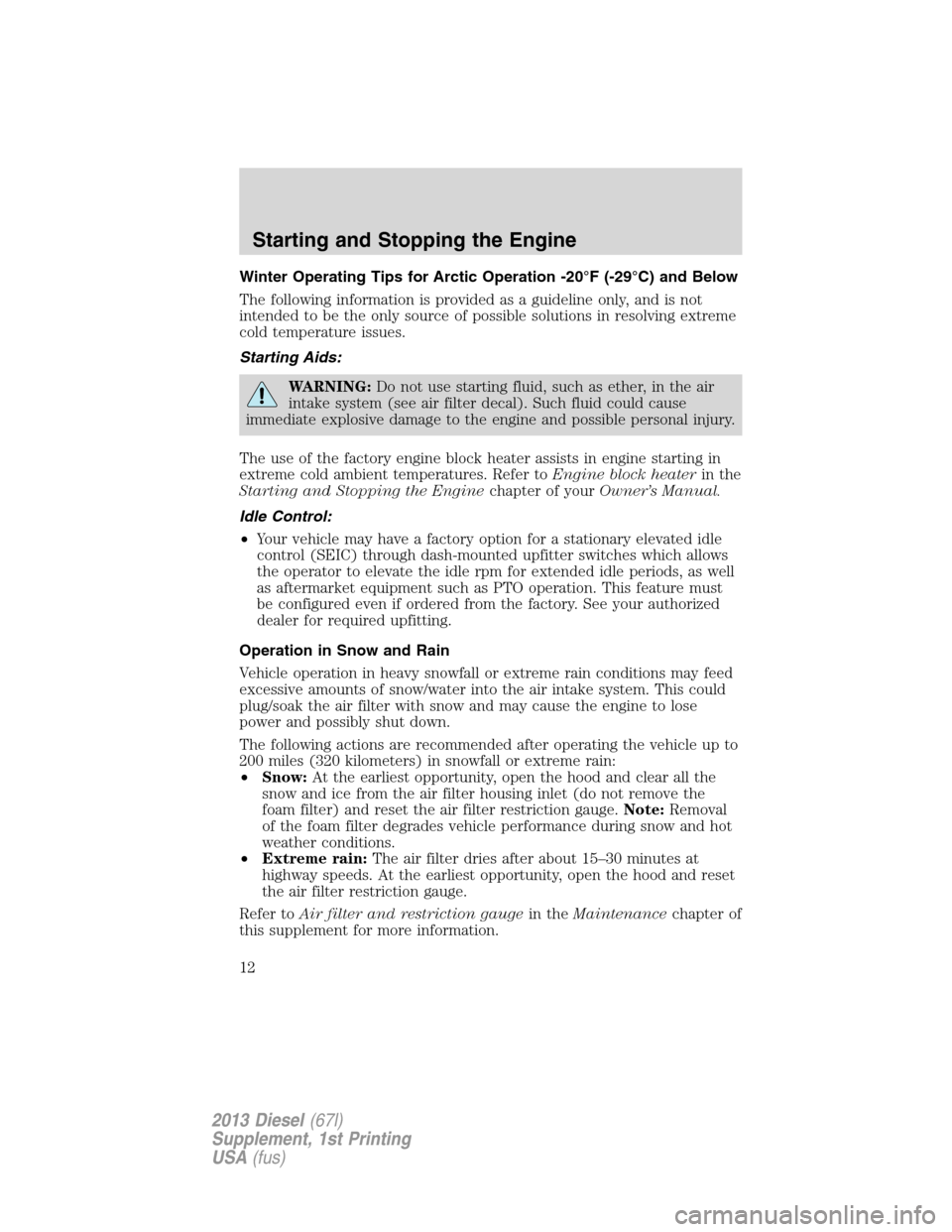
Winter Operating Tips for Arctic Operation -20°F (-29°C) and Below
The following information is provided as a guideline only, and is not
intended to be the only source of possible solutions in resolving extreme
cold temperature issues.
Starting Aids:
WARNING:Do not use starting fluid, such as ether, in the air
intake system (see air filter decal). Such fluid could cause
immediate explosive damage to the engine and possible personal injury.
The use of the factory engine block heater assists in engine starting in
extreme cold ambient temperatures. Refer toEngine block heaterin the
Starting and Stopping the Enginechapter of yourOwner’s Manual.
Idle Control:
•Your vehicle may have a factory option for a stationary elevated idle
control (SEIC) through dash-mounted upfitter switches which allows
the operator to elevate the idle rpm for extended idle periods, as well
as aftermarket equipment such as PTO operation. This feature must
be configured even if ordered from the factory. See your authorized
dealer for required upfitting.
Operation in Snow and Rain
Vehicle operation in heavy snowfall or extreme rain conditions may feed
excessive amounts of snow/water into the air intake system. This could
plug/soak the air filter with snow and may cause the engine to lose
power and possibly shut down.
The following actions are recommended after operating the vehicle up to
200 miles (320 kilometers) in snowfall or extreme rain:
•Snow:At the earliest opportunity, open the hood and clear all the
snow and ice from the air filter housing inlet (do not remove the
foam filter) and reset the air filter restriction gauge.Note:Removal
of the foam filter degrades vehicle performance during snow and hot
weather conditions.
•Extreme rain:The air filter dries after about 15–30 minutes at
highway speeds. At the earliest opportunity, open the hood and reset
the air filter restriction gauge.
Refer toAir filter and restriction gaugein theMaintenancechapter of
this supplement for more information.
Starting and Stopping the Engine
12
2013 Diesel(67l)
Supplement, 1st Printing
USA(fus)
Page 16 of 95

FUEL REQUIREMENTS - CHOOSING THE RIGHT FUEL: VEHICLES
OPERATED WHERE ULTRA LOW SULFUR DIESEL FUEL IS NOT
REQUIRED
For the engine to operate reliably on low-sulfur or high-sulfur diesel fuel,
the engine must be a factory built high-sulfur engine (available as a
dealer order option for select markets) or a ULSD (ultra low sulfur
diesel) fuel configured engine that has been retrofitted for high-sulfur
diesel fuel using Ford Motor Company dealer service parts. Failure to use
retrofit components other than those available through your authorized
dealer will result in engine coolant system damage, engine overheating,
SCR and/or DPF damage and possible base engine damage.
Use only a diesel engine that has been configured for use with high
sulfur diesel fuel in markets with diesel fuel that has sulfur content
greater than 15 ppm. Using low sulfur diesel fuel (16–500 ppm) or
high sulfur diesel fuel (greater than 500 ppm) in a diesel engine
designed to use only Ultra Low Sulfur Diesel fuel may result in
damage to engine emission control devices and the aftertreatment
system, potentially rendering the vehicle inoperable.
Vehicles with engines configured for use with high sulfur diesel fuel will
only be made available for sale in countries where ULSD fuel is generally
not available or mandated by the government. Vehicles originally sold in
a ULSD fuel market that are subsequently exported to non-ULSD fuel
markets will need to be retrofitted (at the customer’s expense using Ford
authorized dealer service parts) in order to be reliably operated on
non-ULSD fuel.
BIODIESEL
WARNING:Do not use home heating oil, agricultural fuel, raw
fats and oils, waste cooking greases, biodiesel fuels greater than
20% or any diesel fuel not intended for highway use. Damage to the
fuel injection system, engine and exhaust catalyst can occur if an
improper fuel is used. Do not add gasoline, gasohol or alcohol to diesel
fuel. This practice creates a serious fire hazard and engine
performance problems.
This vehicle may be operated on diesel fuels containing up to 20%
biodiesel, also known as B20.
Biodiesel fuel is a product that has been chemically converted from
renewable fuel sources, such as vegetable oils, animal fats and waste
cooking greases.
Fuel and Refueling
15
2013 Diesel(67l)
Supplement, 1st Printing
USA(fus)
Page 18 of 95
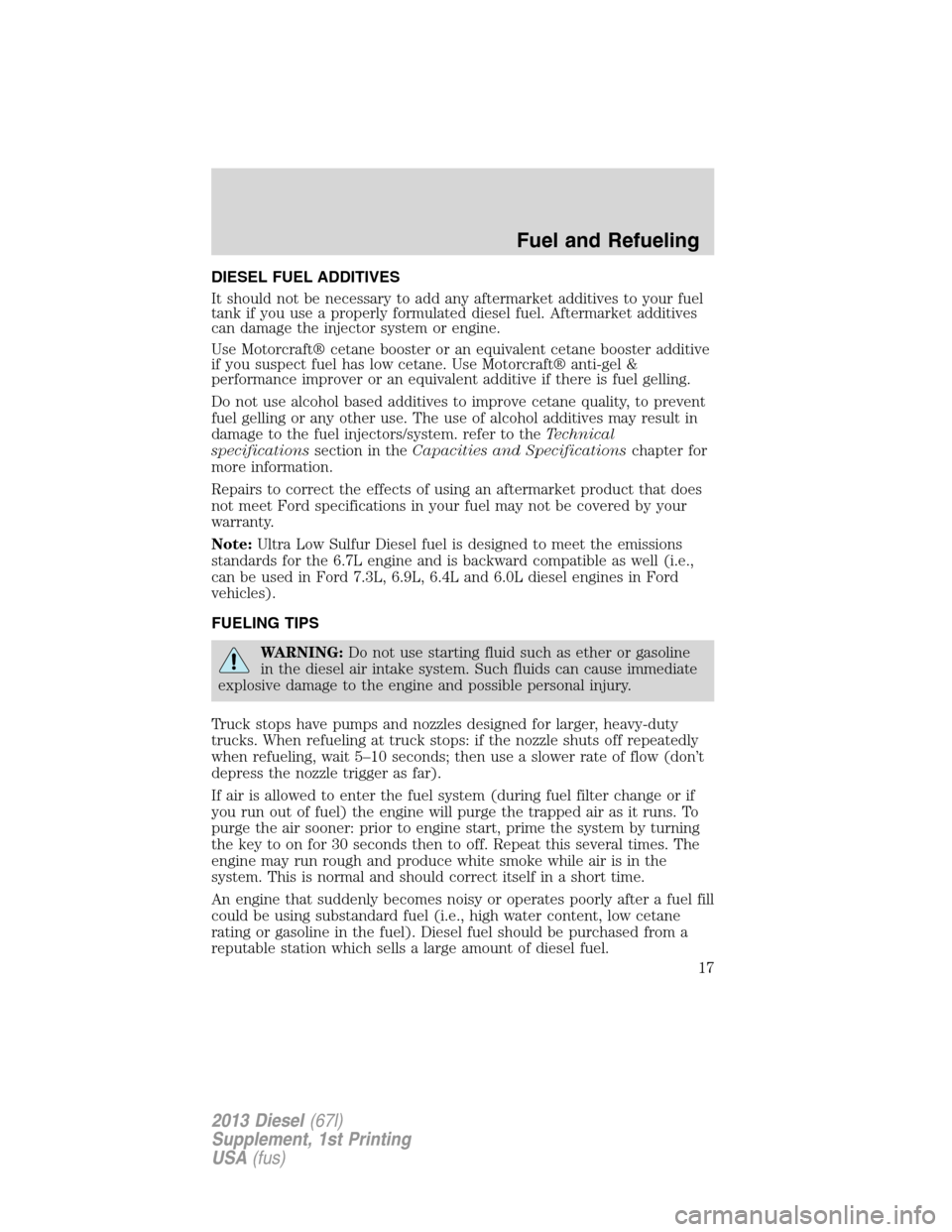
DIESEL FUEL ADDITIVES
It should not be necessary to add any aftermarket additives to your fuel
tank if you use a properly formulated diesel fuel. Aftermarket additives
can damage the injector system or engine.
Use Motorcraft® cetane booster or an equivalent cetane booster additive
if you suspect fuel has low cetane. Use Motorcraft® anti-gel &
performance improver or an equivalent additive if there is fuel gelling.
Do not use alcohol based additives to improve cetane quality, to prevent
fuel gelling or any other use. The use of alcohol additives may result in
damage to the fuel injectors/system. refer to theTechnical
specificationssection in theCapacities and Specificationschapter for
more information.
Repairs to correct the effects of using an aftermarket product that does
not meet Ford specifications in your fuel may not be covered by your
warranty.
Note:Ultra Low Sulfur Diesel fuel is designed to meet the emissions
standards for the 6.7L engine and is backward compatible as well (i.e.,
can be used in Ford 7.3L, 6.9L, 6.4L and 6.0L diesel engines in Ford
vehicles).
FUELING TIPS
WARNING:Do not use starting fluid such as ether or gasoline
in the diesel air intake system. Such fluids can cause immediate
explosive damage to the engine and possible personal injury.
Truck stops have pumps and nozzles designed for larger, heavy-duty
trucks. When refueling at truck stops: if the nozzle shuts off repeatedly
when refueling, wait 5–10 seconds; then use a slower rate of flow (don’t
depress the nozzle trigger as far).
If air is allowed to enter the fuel system (during fuel filter change or if
you run out of fuel) the engine will purge the trapped air as it runs. To
purge the air sooner: prior to engine start, prime the system by turning
the key to on for 30 seconds then to off. Repeat this several times. The
engine may run rough and produce white smoke while air is in the
system. This is normal and should correct itself in a short time.
An engine that suddenly becomes noisy or operates poorly after a fuel fill
could be using substandard fuel (i.e., high water content, low cetane
rating or gasoline in the fuel). Diesel fuel should be purchased from a
reputable station which sells a large amount of diesel fuel.
Fuel and Refueling
17
2013 Diesel(67l)
Supplement, 1st Printing
USA(fus)
Page 19 of 95
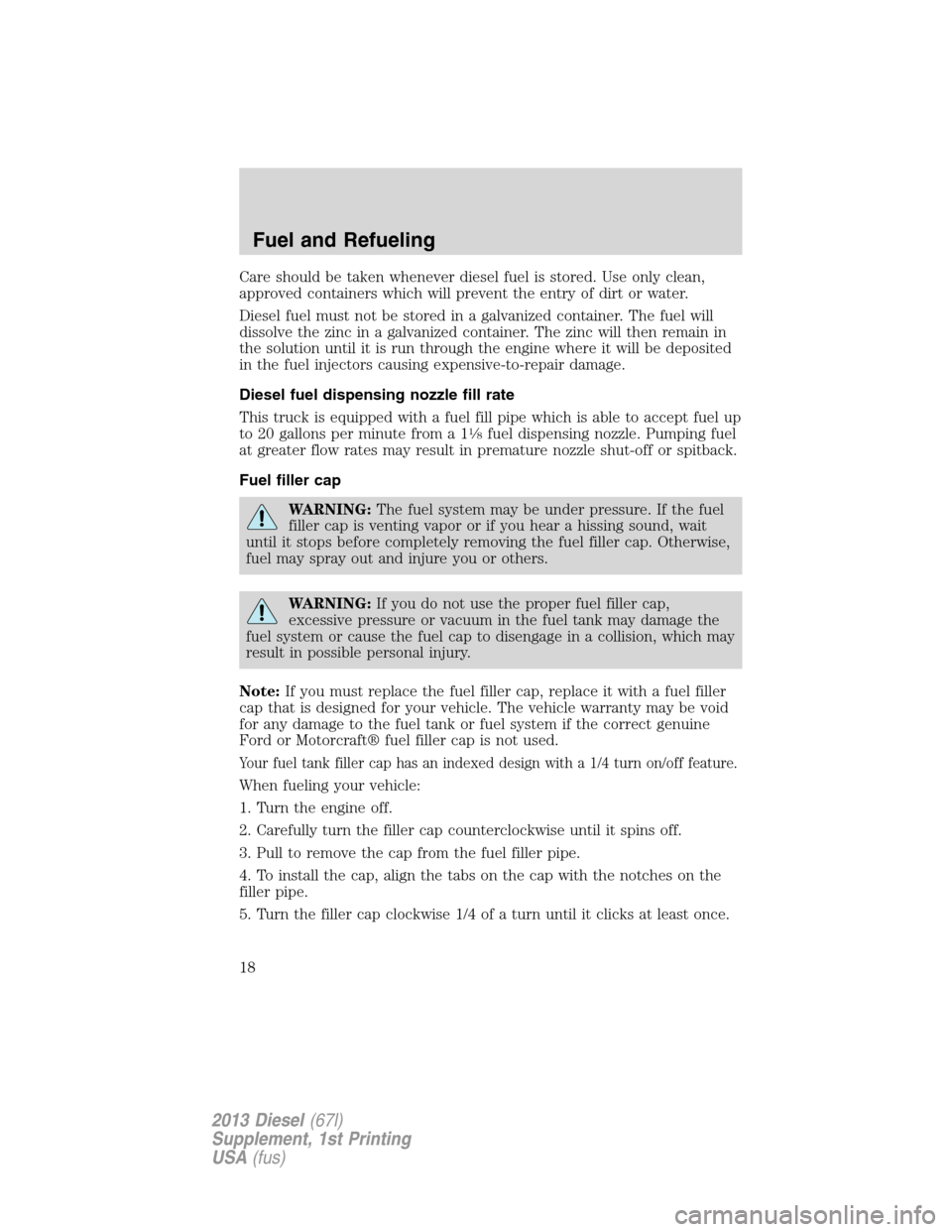
Care should be taken whenever diesel fuel is stored. Use only clean,
approved containers which will prevent the entry of dirt or water.
Diesel fuel must not be stored in a galvanized container. The fuel will
dissolve the zinc in a galvanized container. The zinc will then remain in
the solution until it is run through the engine where it will be deposited
in the fuel injectors causing expensive-to-repair damage.
Diesel fuel dispensing nozzle fill rate
This truck is equipped with a fuel fill pipe which is able to accept fuel up
to 20 gallons per minute from a 1
1�8fuel dispensing nozzle. Pumping fuel
at greater flow rates may result in premature nozzle shut-off or spitback.
Fuel filler cap
WARNING:The fuel system may be under pressure. If the fuel
filler cap is venting vapor or if you hear a hissing sound, wait
until it stops before completely removing the fuel filler cap. Otherwise,
fuel may spray out and injure you or others.
WARNING:If you do not use the proper fuel filler cap,
excessive pressure or vacuum in the fuel tank may damage the
fuel system or cause the fuel cap to disengage in a collision, which may
result in possible personal injury.
Note:If you must replace the fuel filler cap, replace it with a fuel filler
cap that is designed for your vehicle. The vehicle warranty may be void
for any damage to the fuel tank or fuel system if the correct genuine
Ford or Motorcraft® fuel filler cap is not used.
Your fuel tank filler cap has an indexed design with a 1/4 turn on/off feature.
When fueling your vehicle:
1. Turn the engine off.
2. Carefully turn the filler cap counterclockwise until it spins off.
3. Pull to remove the cap from the fuel filler pipe.
4. To install the cap, align the tabs on the cap with the notches on the
filler pipe.
5. Turn the filler cap clockwise 1/4 of a turn until it clicks at least once.
Fuel and Refueling
18
2013 Diesel(67l)
Supplement, 1st Printing
USA(fus)